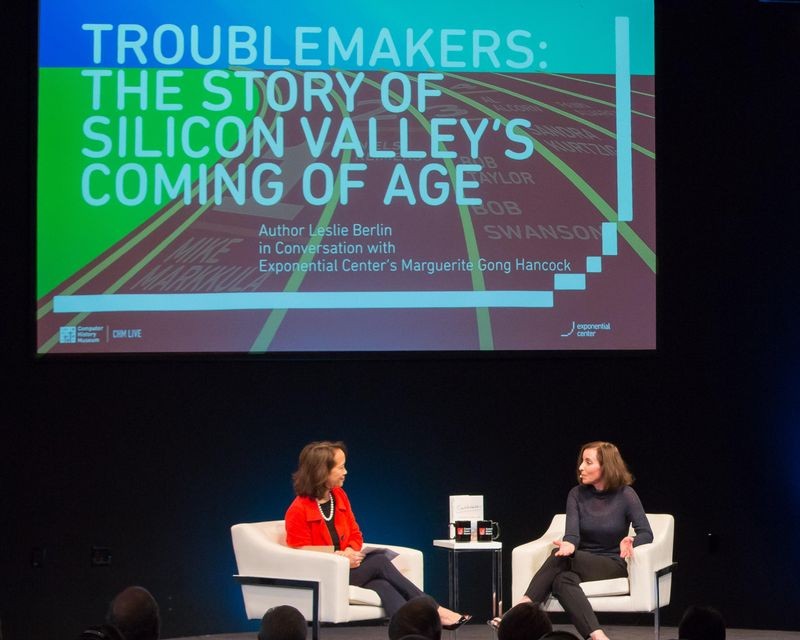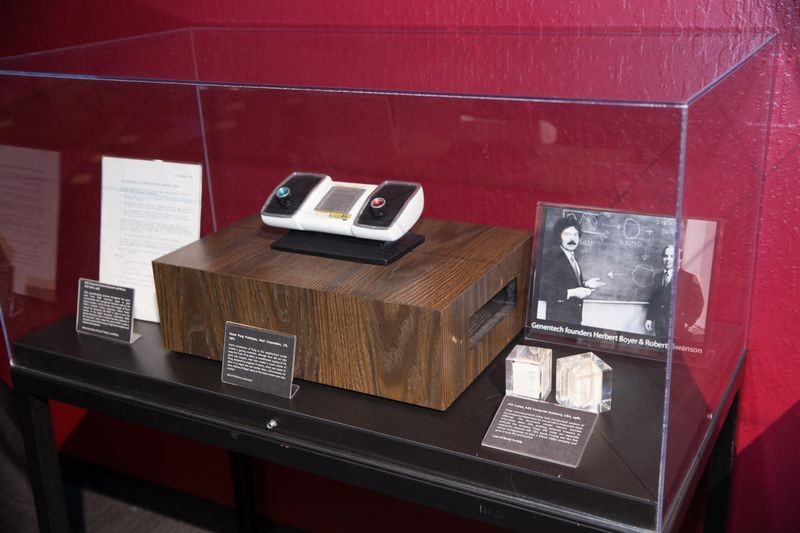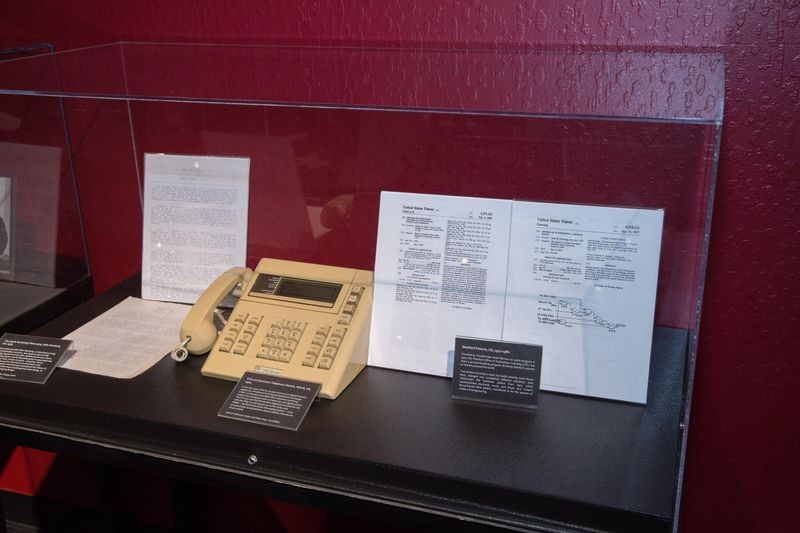

“Troublemakers: The Story of Silicon Valley’s Coming of Age — Historian and Author Leslie Berlin in Conversation with the Exponential Center’s Marguerite Gong Hancock,” December 13, 2017. Produced by the Exponential Center at the Computer History Museum.
One of Silicon Valley’s great advantages, says author Leslie Berlin, is how accessible experienced founders and legendary CEOs are to the next generation of entrepreneurs. Steve Jobs counted David Packard of Hewlett-Packard and Robert Noyce of Intel among his mentors. Facebook’s young founder Mark Zuckerberg looked to Jobs for advice and also to Bob Taylor of Xerox PARC. Taylor is one of the seven pioneering individuals featured in Leslie Berlin’s book Troublemakers: Silicon Valley’s Coming of Age. Together, these “troublemakers” disrupted the world because they imagined a better future and were driven to help create it. Project historian for the Silicon Valley Archives at Stanford University, Berlin spoke about her book in a fireside chat at the Computer History Museum (CHM) with the Exponential Center’s Marguerite Gong Hancock on December 13, 2017.
Berlin selected the time period, 1969−1976, by the simple method of placing dots representing important events in Silicon Valley on a timeline and noticing a significant concentration. In the course of those seven years, five new industries were launched within a 35-mile radius: advanced semiconductor logic, biotechnology, personal computing, modern venture capital, and, last but not least, video games. In addition, the celebrity entrepreneur was born as well as two important lobbying organizations and Stanford’s innovative Office of Technology Licensing.
Although famous figures like Steve Jobs, Regis McKenna, and Larry Ellison make appearances in the book, Berlin opted not to write a traditional biography about one heroic person. Instead, she selected lesser-known individuals who represent the overlooked truth that success is a team effort even—or especially—in Silicon Valley. Her cast of interesting and engaging characters includes Apple chairman Mike Markkula; Xerox PARC’s Bob Taylor; Sandra Kurtzig, founder of ASK, one of the first software companies; Genentech cofounder Bob Swanson; Atari’s Al Alcorn, who built the video game Pong; ROLM’s Fawn Alvarez, who started her career on the assembly line; and, Stanford’s Niels Reimers, who established the Office of Technology Licensing.
The interweaving of these individuals’ seven lives makes for a compelling story that amplifies the interconnections and informal networks between people and companies in the early years of Silicon Valley’s development. Berlin makes the case that iconic companies like Atari and Apple would not have succeeded without people who stood just outside of the spotlight.
Author and historian Leslie Berlin on how Mike Markkula managed Apple’s success.
Berlin sheds light on the tight ties between the development of the ARPANET and the birth of the personal computer industry. Bob Taylor, who started the ARPANET, took many of his engineers with him when he began running the computer science lab at Xerox PARC where they developed the Alto computer. With a psychology degree from the University of Texas, Bob Taylor has been described as “a concert pianist without fingers.” He had a vision for distributed computing but not the skills to develop it himself so he recruited and managed the elite scientists who could. The president of MIT worried that it would be difficult to staff academic computer science departments because everyone was working for Taylor.
Gender issues are addressed in Berlin’s telling of the stories of Sandy Kurtzig, the first woman to take a tech company public, and Fawn Alvarez, who worked her way up from the assembly line at ROLM computers. There were women working everywhere in the tech industry, Berlin notes, often treated like “one of the boys” within a larger sexist culture where, until 1974, a woman couldn’t get a credit card without her husband’s approval. It wasn’t until 1980 that the Equal Employment Opportunity Commission (EEOC) recognized sexual harassment in the workplace. In such a world, Sandy Kurtzig was mistaken for a “booth babe” at tech conferences.
Sandy Kurtzig bootstraps that mysterious thing: software.
The conflicted relationship between the counterculture and government-funded defense contractors is exemplified by the story of Al Alcorn, an engineer who worked for Atari and exposed the masses to computing through Pong, one of the earliest arcade video games. At a time when the Vietnam War and Watergate made young people suspicious of big government and corporations, computer science majors often worked at defense contractors in the Valley and then took their skills to new startups.
How counterculture made technology for the masses.
The stories of Bob Swanson, who cofounded Genentech, one of the first biotechnology companies, and Niels Riemers, who founded the Office of Technology Licensing at Stanford are told together through the patenting of recombinant DNA. Licensing scientific discoveries was a new idea at the time as many scientific breakthroughs relied on public research funds and were perceived as building on previous research. Riemers saw that biotech would be a game changer and fought to get a crucial law passed that allowed the university to benefit from its research. At the same time, venture capitalists were also able to obtain favorable legislation that cut taxes on capital gains and allowed pension funds to invest in risky new companies. Today however, Berlin points out, Silicon Valley is not enjoying the kind of government and public support it has in the past.
Is Silicon Valley losing its power?
Silicon Valley’s ability to reinvent itself is legendary. Berlin believes the key to this reinvention is immigration. A draw for the world’s best and brightest, the proportion of immigrants in the area has always been higher than in the rest of the United States. Today, of people between 25 and 44 years old in science and technology, two-thirds were born outside of the US, and 50 percent of unicorn companies have a foreign-born founder or cofounder. Risk-takers by definition, immigrants constantly refresh the system. Tightening immigration laws, Berlin says, would endanger this vital pipeline.
Though she named her book Troublemakers, Berlin warns not to mistake disruption as an end in itself. The people she features pushed against existing structures not for the sake of disruption alone, but to pursue a larger idea. They were team players who were audacious and persistent but didn’t mistake their own egos for the product or company. Their most powerful and under-appreciated talent? Humility.
“Troublemakers: The Story of Silicon Valley’s Coming of Age — Historian and Author Leslie Berlin in Conversation with the Exponential Center’s Marguerite Gong Hancock,” December 13, 2017. Produced by the Exponential Center at the Computer History Museum.

From left to right: DEC Computer Systems Research Memo, 1983; Home Pong Prototype, ca. 1974; and IPO Cubes, 1981.
After groundbreaking advances throughout the 1970s, some Xerox PARC researchers began to grow uncomfortable with management decisions made by the parent company. Led by founder and manager of Xerox PARC’s Computer Science Laboratory, Robert Taylor, several top researchers left PARC in 1983 to form the nucleus of the Digital Equipment Corporation (DEC) Systems Research Center in nearby Palo Alto, California. In this document, Taylor makes the case for DEC to start a computer systems lab focusing on high-level computer and software development.
Gift of the Estate of Chuck Thacker, 102786530
Atari’s introduction of Pong to the neighborhood arcade created a gaming revolution, although Atari did not fully enjoy the fruits of its labors as unauthorized copying of the game was rampant. Atari then created a home version of Pong, designed by engineer Al Alcorn, which was meant to allow it to regain this lost market share. Unfortunately for Atari, millions of illegal copies of the home version were also created.
Gift of Al Alcorn, 102711719
These commemorative cubes hold miniaturized versions of the prospectus statements for two of ASK’s three public stock offerings. The documents contain relevant business information about ASK, enabling potential investors to evaluate the company. These IPO cubes are especially noteworthy because ASK CEO Sandy Kurtzig was the first woman entrepreneur to start a Silicon Valley company and grow it to an IPO and beyond.
Loan of Sandy Kurtzig

From left to right: Apple Marketing Philosophy, 1979 and ETS 100 Electric Telephone Station, 1979
Steve Jobs recruited Mike Markkula, a retired (but young) Intel marketing executive, into Apple in 1977 to help develop Apple’s business plan. Markkula penned a memo describing Apple’s marketing philosophy in 1979 beginning with three clear, simple concepts—Empathy, Focus, Impute. These prime directives would remain a key element in Apple’s development throughout the history of the company, informing everything from advertising, to product and packaging design.
Gift of Mike Markkula, X4554.2008
In the late 1970s, ROLM, an early entrant into digital business telephony, introduced its Computerized Branch Exchange (CBX), a computer controlled office telephone switching system that combined voice and data into one digital system. The ETS 100 was ROLM’s earliest telephone terminal for use with the CBX; it could support up to four lines, and, using REMS—the ROLM Electronic Messaging System—even provided basic email between stations before commercial email existed.
Gift of Catherine Healy and Diane Gee, 102756964
About the This event is produced by the Exponential Center. The Exponential Center captures the legacy — and advances the future — of entrepreneurship and innovation in Silicon Valley and around the world. The center explores the people, companies, and communities that are transforming the human experience through technology innovation, economic value creation, and social impact. Our mission: to inform, influence, and inspire the next generation of innovators, entrepreneurs, and leaders changing the world.